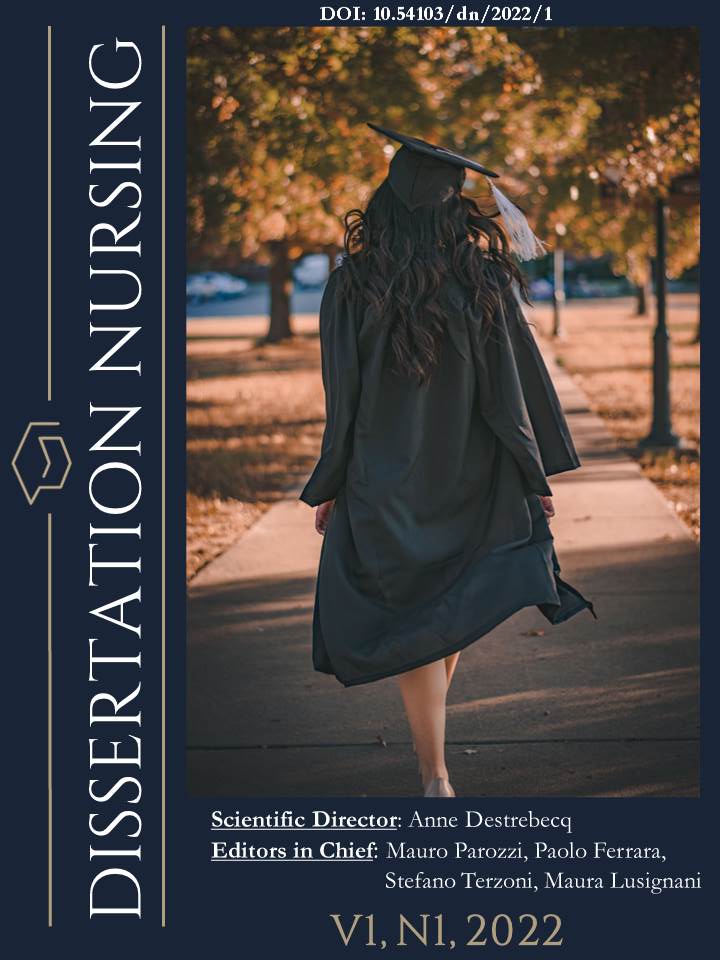Consegna infermieristica con metodo SBAR: uno studio quasi-sperimentale
DOI:
https://doi.org/10.54103/dn/17691Parole chiave:
continuità dell'assistenza, passaggio di consegne, comunicazione, consegne infermieristicheAbstract
INTRODUZIONE:
Il passaggio delle consegne è un aspetto cruciale per la sicurezza del paziente e per la continuità delle cure. Molti fattori possono influenzare la qualità delle informazioni trasmesse rendendo il processo inefficace o addirittura dannoso se le informazioni sono incomplete o omesse.
OBIETTIVI:
L'obiettivo primario dello studio era descrivere i cambiamenti nella qualità della consegna infermieristica dopo l'introduzione del metodo Situation, Background, Assestment and Raccomandation (SBAR).
Gli obiettivi secondari erano la descrizione dei cambiamenti nel numero di interruzioni e dei cambiamenti nelle abilità di comunicazione nell'handover infermieristico.
MATERIALI E METODI:
Uno studio quasi sperimentale, monocentrico con disegno pre/post test è stato implementato con un campionamento di convenienza.
RISULTATI:
198 infermieri hanno partecipato allo studio e sono stati analizzati 208 handover infermieristici.
Dopo l'introduzione del metodo SBAR c'è stato un miglioramento significativo della qualità dei passaggi di consegne, una riduzione del numero di interruzioni e un aumento delle capacità di comunicazione.
CONCLUSIONI:
Il metodo SBAR migliora la qualità delle consegne infermieristiche riducendo il numero di interruzioni e migliorando le capacità di comunicazione.
L'introduzione del metodo di consegna SBAR contribuisce alla qualità ed alla sicurezza della trasmissione delle informazioni.
Riferimenti bibliografici
Vitale E, Cannito G. [Observational study of the handover with the SBAR method at Bari Polyclinic complex]. Prof Inferm. 2020;73(1):27–32.
Johnson M, Sanchez P, Suominen H, Basilakis J, Dawson L, Kelly B, et al. Comparing nursing handover and documentation: forming one set of patient information. Int Nurs Rev. 2014 Mar;61(1):73–81.
Iavarone D. Il passaggio della consegna infermieristica, ne abbiamo davvero bisogno? Alla ricerca di opportunità di miglioramento. L’infermiere. 2014;4.
Stewart K. SBAR, communication, and patient safety: an integrated literature review. University of Tennessee at Chattanooga; 2016.
Streeter AR, Harrington NG. Nurse Handoff Communication. Semin Oncol Nurs. 2017;33(5):536–43.
Müller M, Jürgens J, Redaèlli M, Klingberg K, Hautz WE, Stock S. Impact of the communication and patient hand-off tool SBAR on patient safety: a systematic review. BMJ Open. 2018;8(8):e022202.
Starmer AJ, Spector ND, Srivastava R, West DC, Rosenbluth G, Allen AD, et al. Changes in Medical Errors after Implementation of a Handoff Program. N Engl J Med. 2014;371(19):1803–12.
Merten H, van Galen LS, Wagner C. Safe handover. BMJ. 2017;359:j4328.
Pucher PH, Johnston MJ, Aggarwal R, Arora S, Darzi A. Effectiveness of interventions to improve patient handover in surgery: A systematic review. Surgery. 2015 Jul;158(1):85–95.
Randmaa M, Mårtensson G, Leo Swenne C, Engström M. SBAR improves communication and safety climate and decreases incident reports due to communication errors in an anaesthetic clinic: a prospective intervention study. BMJ Open. 2014 Jan 21;4(1):e004268.
Braaf S, Rixon S, Williams A, Liew D, Manias E. Medication communication during handover interactions in specialty practice settings. J Clin Nurs. 2015 Oct;24(19–20):2859–70.
Hasan H, Ali F, Barker P, Treat R, Peschman J, Mohorek M, et al. Evaluating handoffs in the context of a communication framework. Surgery. 2017;161(3):861–8.
Ferrara P, Terzoni S, Davì S, Bisesti A, Destrebecq A. A tool for assessing the quality of nursing handovers: a validation study. Br J Nurs Mark Allen Publ. 2017 Aug 10;26(15):882–8.
Flemming D, Hübner U. How to improve change of shift handovers and collaborative grounding and what role does the electronic patient record system play? Results of a systematic literature review. Int J Med Inf. 2013 Jul;82(7):580–92.
De Meester K, Verspuy M, Monsieurs KG, Van Bogaert P. SBAR improves nurse-physician communication and reduces unexpected death: a pre and post intervention study. Resuscitation. 2013 Sep;84(9):1192–6.
Blom L, Petersson P, Hagell P, Westergren A. The Situation, Background, Assessment and Recommendation (SBAR) Model for Communication between Health Care Professionals: A Clinical Intervention Pilot Study. Int J Caring Sci. 2015;8(3):530–5.
Kostoff M, Burkhardt C, Winter A, Shrader S. An Interprofessional Simulation Using the SBAR Communication Tool. Am J Pharm Educ. 2016 Nov 25;80(9):157.
Zou X-J, Zhang Y-P. Rates of Nursing Errors and Handoffs-Related Errors in a Medical Unit Following Implementation of a Standardized Nursing Handoff Form. J Nurs Care Qual. 2016;31(1):61–7.
Jewell JA, COMMITTEE ON HOSPITAL CARE. Standardization of Inpatient Handoff Communication. Pediatrics. 2016;138(5).
Mardis M, Davis J, Benningfield B, Elliott C, Youngstrom M, Nelson B, et al. Shift-to-Shift Handoff Effects on Patient Safety and Outcomes. Am J Med Qual Off J Am Coll Med Qual. 2017;32(1):34–42.
Ferrara P, Terzoni S, Davì S, Bisesti A, Destrebecq A. A tool for assessing the quality of nursing handovers: a validation study. Br J Nurs Mark Allen Publ. 2017 Aug 10;26(15):882–8.
Smeulers M, Vermeulen H. Best of both worlds: combining evidence with local context to develop a nursing shift handover blueprint. Int J Qual Health Care J Int Soc Qual Health Care. 2016 Dec 1;28(6):749–57.
Dowloads
Pubblicato
Come citare
Fascicolo
Sezione
Licenza
Copyright (c) 2022 Maria Cristina Monti , Stefano Maiandi, Lucia Rossi, Miriam Villani, Cinzia Garofalo

Questo lavoro è fornito con la licenza Creative Commons Attribuzione - Non commerciale - Non opere derivate 4.0 Internazionale.
Accettato 2022-05-18
Pubblicato 2022-07-29













